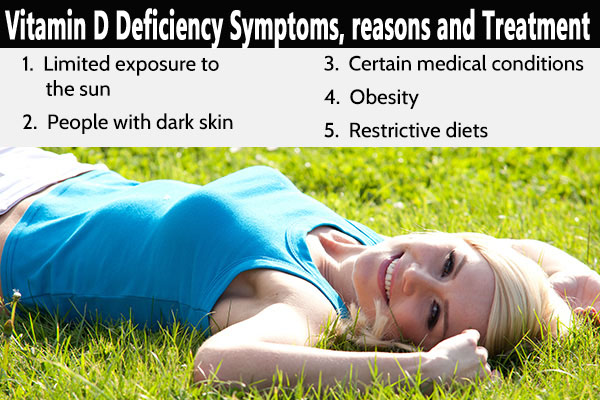

Vitamin D Deficiency Symptoms, Reasons, and Treatment.
Vitamin D Deficiency Symptoms, Reasons, and Treatment. It’s possible to be vitamin D deficient if you don’t go out in the sun, have milk allergies, or eat a vegan diet exclusively.
Known as the sunlight vitamin, vitamin D is produced by the body in response to exposure to sunlight. It is found naturally in a few foods – including some fish, fish liver oil, and egg yolks – and in strong dairy and cereal products.
Vitamin D is essential for strong bones.
Vitamin D is essential for strong bones as it helps the body absorb calcium from the diet. Traditionally, vitamin D deficiency has been linked to rickets, a disease in which bone tissue is not properly mineralized, leading to soft bone and skeletal damage. But research is increasingly emphasizing the role of vitamin D in guarding against a wide range of health issues, including heart disease and cancer.
Vitamin D deficiency symptoms and health risks
Symptoms of bone pain and muscle weakness may mean that you are deficient in vitamin D. However, for many people, the symptoms are fine. However, even in the absence of symptoms, too little vitamin D can be harmful to your health. Blood Vitamin D levels are linked to the following.
Increased risk of death from heart disease.
Cognitive impairment in the elderly.
Severe asthma in children.
Cancer
Research shows that vitamin D can play a role in the prevention and treatment of many different conditions, including type 1 and type 2 diabetes, hypertension, glucose intolerance, and multiple sclerosis.
Causes of Vitamin D Deficiency
Many factors can contribute to vitamin D insufficiency, including:
You do not use the recommended levels of vitamins over time. This is possible if you follow a strict vegan diet, as most natural sources are based on animals, including fish and fish oils, egg yolks, strong milk, and beef liver.
You may also like this:
Find Belly Fat Is Resistant to Intermittent fasting benefits and risks
5 Shower Mistakes That Can Wreck Your Skin
Three best types of exercise to lose weight in 2021
Your exposure is limited to sunlight. Because the body makes vitamin D when your skin is exposed to sunlight, you may be at risk for deficiency if you are at home, living in the northern hemisphere, wearing long dresses, or wearing headscarves for religious reasons. Cover, or have a profession that prevents sun exposure. During the winter, vitamin D deficiency may be more common because there is less sunlight available.
Your skin is black. UV-induced vitamin D deficiency is caused by the melanin pigment. Aged individuals with darker skin had a greater risk of vitamin D insufficiency, according to several research
When it comes to vitamin D, your kidneys are unable to convert it into its active form. As people age, their kidneys are unable to convert vitamin D into its active form, increasing their risk of vitamin D deficiency.
Your digestive system cannot properly absorb vitamin D. Certain medical problems, including Crohn’s disease, cystic fibrosis, and celiac disease can affect your gut’s ability to absorb vitamin D in your diet.
You are fat Vitamin D is extracted from the blood through fat cells, and converts its circulation into circulation. People with a body mass index of 30 or higher have lower levels of vitamin D in their blood.
Vitamin D deficiency tests
A 25-hydroxy vitamin D blood test is the most reliable technique to assess how much vitamin D your body possesses. For healthy adults, levels between 20 ng/ml and 50 ng/ml are deemed acceptable. Under 12ng/mL indicates a deficiency.
Treatment of vitamin D deficiency
Vitamin D deficiency can be treated by increasing vitamin D intake through diet and supplementation. A concentration of less than 20 mg per ml of vitamin D is usually considered insufficient and requires treatment, despite the fact that there is no consensus on the level of vitamin D required for optimal health.
The Institute of Medicine guidelines increased the recommended dietary allowance (RDA) of vitamin D to 600 international units (IU) per person aged 1-70 years and 70 years to improve bone health. Increased to 800 IU for adults over. Safe upper limit increased to 4000 IU. Doctors can prescribe more than 4,000 IUs to treat vitamin D deficiency.
If you do not spend much time in the sun or are always careful to cover your skin (sunscreen prevents the production of vitamin D), you should talk to your doctor about taking vitamin D supplements, especially if You have risk factors for vitamin D deficiency.
Read more:
Vaginal Cysts Causes Symptoms and Treatments
HOW CONSTIPATION IMPACTS HEALTH
Simple Ways to Naturally Whiten Your Teeth at Home